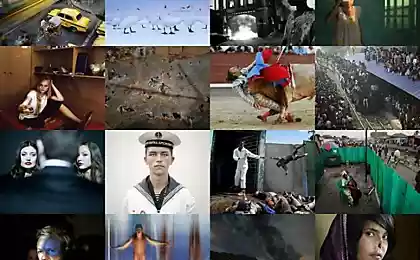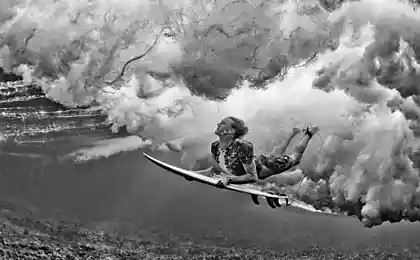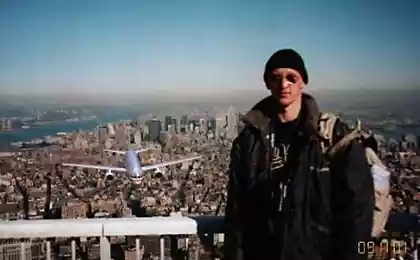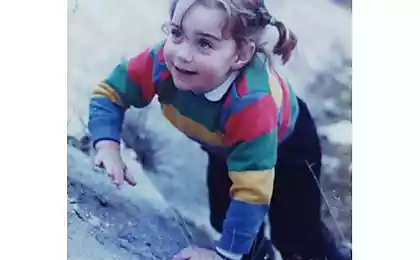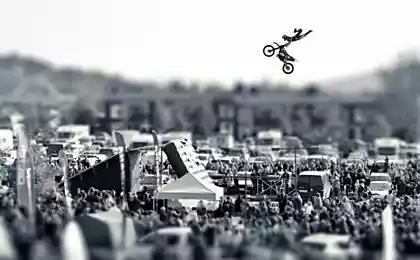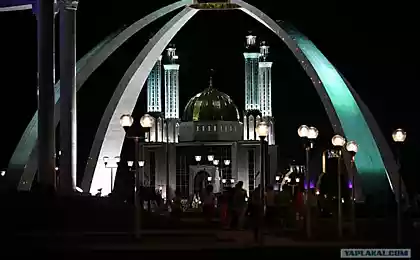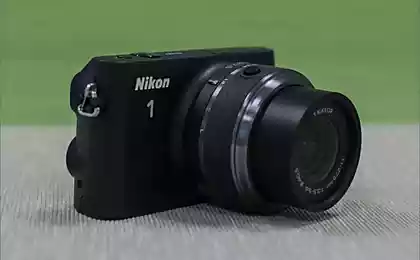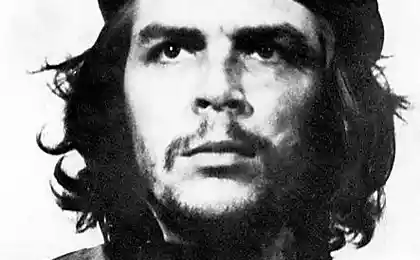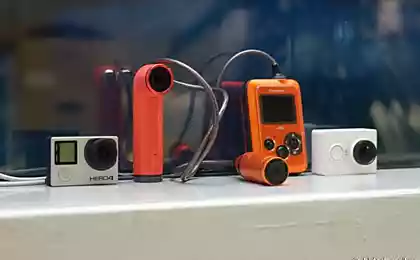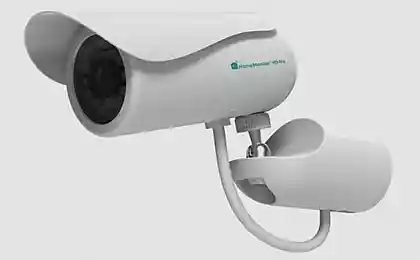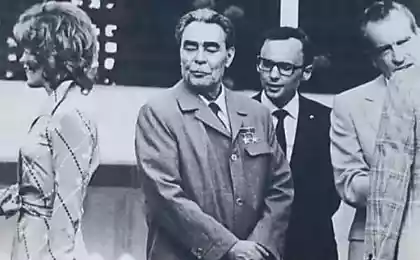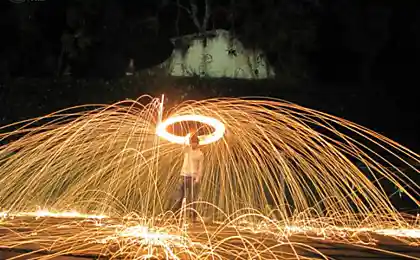2218
Camera Einstein as a photographer shows a time
Adam Magyar - computer geek who abandons the university, a self-taught photographer, Rube Goldberg of high technology, the world traveler and conceptual artist with a growing worldwide recognition. But no one could have imagined that it could be even a terrorist, before the morning until he went to the metro station Union Square in New York City.
While Magyar was immersed in long-term project at the intersection of technology and art called Stainless i> («Perfect"), creating high-resolution images of the passing trains and passengers using sophisticated, written by his own software and modified industrial camera. Scanning technique, which he developed - bringing together thousands of frames in width in pixels in one image - allows him to surprise the passengers by surprise, as they noise and clang fly through the dark tunnels of the subway, fixing them in ghostly images, filled with details that can not capture neither ordinary camera.
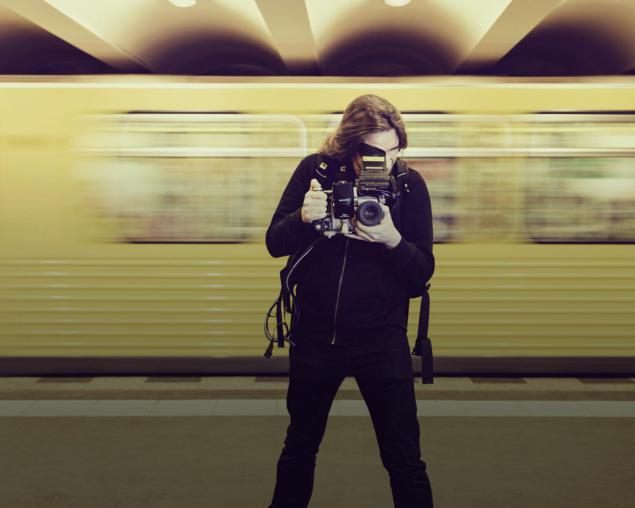
Magyar established his usual set of devices - cameras, scanners, voltmeters, blue and black cables, batteries, tripod, laptop - and waited until the train rolled out onto the platform. What he did not expect was the vigilance of survivors of September 11 New Yorkers, some of whom complained to the police on a man with long hair, having with him something that looked like a hastily assembled equipment for surveillance. It was not long before he was approached by an employee of the transport police.
- What are you doing? - He asked.
- I scan the train - Magyar said.
Police took Magyar room in the bowels of the station Union Square, which caused a couple of plainclothes officers, so that they questioned him. They examined its equipment, carefully watched his digital files. "Tell us who you work for?" - Followed by their question.
Once Magyar convinced them that it is not exploring the underground illegal purposes, that he is an artist (this helped his website , which were examples his works), the police agreed to a $ 25 fine for violating the rule prohibiting the use of a tripod at the station, and let him go back home.
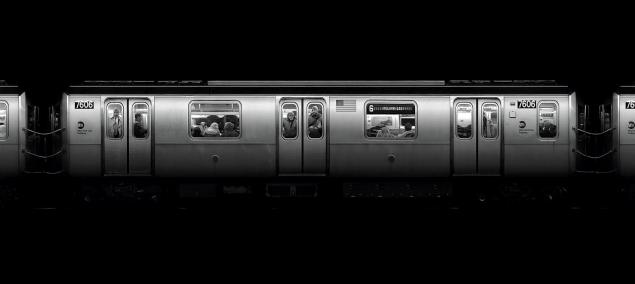
From the series Stainless i>, New York, 2010. Printed works have a length of more than 2, 5 m. h6>
While Magyar was immersed in long-term project at the intersection of technology and art called Stainless i> («Perfect"), creating high-resolution images of the passing trains and passengers using sophisticated, written by his own software and modified industrial camera. Scanning technique, which he developed - bringing together thousands of frames in width in pixels in one image - allows him to surprise the passengers by surprise, as they noise and clang fly through the dark tunnels of the subway, fixing them in ghostly images, filled with details that can not capture neither ordinary camera.

Magyar established his usual set of devices - cameras, scanners, voltmeters, blue and black cables, batteries, tripod, laptop - and waited until the train rolled out onto the platform. What he did not expect was the vigilance of survivors of September 11 New Yorkers, some of whom complained to the police on a man with long hair, having with him something that looked like a hastily assembled equipment for surveillance. It was not long before he was approached by an employee of the transport police.
- What are you doing? - He asked.
- I scan the train - Magyar said.
Police took Magyar room in the bowels of the station Union Square, which caused a couple of plainclothes officers, so that they questioned him. They examined its equipment, carefully watched his digital files. "Tell us who you work for?" - Followed by their question.
Once Magyar convinced them that it is not exploring the underground illegal purposes, that he is an artist (this helped his website , which were examples his works), the police agreed to a $ 25 fine for violating the rule prohibiting the use of a tripod at the station, and let him go back home.

From the series Stainless i>, New York, 2010. Printed works have a length of more than 2, 5 m. h6>
It was not the first time Adam Magyar had to explain his work intrigued observers. Born in 1972 in Hungary, Magyar started taking pictures when he was much in twenty wandering the streets of Asian cities and taking photos of Indian street vendors, monks and the Himalayan-Hindu students. His work went quickly evolved from conventional documentary photography to surreal radically experimental images that reflect his passion for finding new and unusual ways to use digital technology. Engineer and self-taught programmer who collected his first computer as a teenager, Magyar making their shots, using some of the most advanced in the world of photographic devices, modified with a program he wrote himself. The additional code, as its authorship, removes almost all of the distortion or noise, from the received data from the camera, producing images of incredible clarity.
In a growing number of photographic and video art created over the last ten years, Magyar bends cherished notions of time and distance, stretching milliseconds to minutes, clutching moments in the resolution that the naked eye could never perceive. His art originates in different sources such as Albert Einstein, Zen Buddhism and even the TV series 60's "Twilight Zone." The images themselves - sleek silver subway cars, serious passengers, lost in their own inner worlds - beautiful and elegant, but also cause anxiety. "The moments that I take are meaningless, they have no history, and if possible to capture the essence, the quintessence of life, it is embodied, perhaps, all" - says Magyar in one of the many mysterious comments about his work, which reflects her hypnotic pull and its elusiveness. There is a feeling that enters into another dimension, taking place between the fixed and the movement in the world distorted by time, where the laws of physics do not work.
«I learned to work with tools, acquired a general understanding of materials. And I learned how to combine different things ». H4> blockquote>
Jobs Magyar is fruitful interaction of technology and art, two disciplines - one objective and mathematical, and the other is completely subjective - which is not always perceived as harmonious or even compatible. However, they are intertwined, and technological breakthroughs often made possible new forms of art. Five thousand years ago, Egyptian craftsmen were heated in the ovens of the desert sand, limestone, potash and copper carbonate, to give a synthetic pigment known as "Egyptian blue", which contributed to the highly realistic stylized portraits of the second and third dynasty.
By the fifteenth century the paint, mix in the transparent oil, flaxseed and walnut oil, began to replace the opaque based on egg yolk tempera, filling art new bright colors and naturalism, which paved the way such Renaissance masters as Jan van Eyck, Tintoretto and Caravaggio. The experiments of the nineteenth century with the light sensitive materials capable to capture and stabilize the image, starting with the silver-coated and treated with iodine vapor copper sheets Louis Daguerre, led to the invention of photography. In the 1950s, the rapid progress in the development of emulsions and film speed allowed the filmmakers to make their craft out into the street and shoot at the minimum light, thereby highlighting the new wave of naturalistic film Jean-Luc Godard and other innovators.
Digital photography, first developed in the 1970s, has given rise to two types of image input devices: a conventional digital cameras and scanners. The first object is removed entirely in a single exposure. The second, by contrast, captures an image sequentially. The sensor is moved along the object, such as a printed document and photograph it line by line, and then collects the total image. Scanners, image editing software and high-speed production video camera allowed conceptual artist to break out of traditional photography and create more and more abstract and surreal images.
Doris Mitch , who lives in northern California, scans plants, marine fauna and other natural objects in your old Mac G4, and then edit in Photoshop, creating stunningly vibrant compositions that are impossible to get the most light-sensitive cameras. Penelope Umbriko creates a huge collage of images found on the network. Her project "541,795 suns (of sunset) on Flickr», created in 2006, reflects her passion for the Internet and how it is to bend under him the other reality. Photographer native of Latvia Misha Gordin creates a frightening black-and-white composite image, such as his famous series Crowd i> ( "Crowd") which cause a feeling of depression totalitarian system. Gordin once wrote: "In conceptual photography ... an idea or a vision transformed camera image associated with the reality of just my imagination. The initial process is similar to writing poetry. Only then it becomes more technical. " Magyar, a fan works Gordin, also creates a black-and-white photos and video, soaked in a similar spirit complication, although its people are connected is not a political system, and the boundaries of their own perception.
I first met Magyar in his neat two-bedroom apartment in Friedrichshain, well-kept area of the former East Berlin. He has long, dark hair liquid beard and mustache, dark eyes thoughtful. He looks like a portrait of the Slavic Renaissance or holy aged rock musician, who lives in one of the last buildings captured by squatters in Berlin.
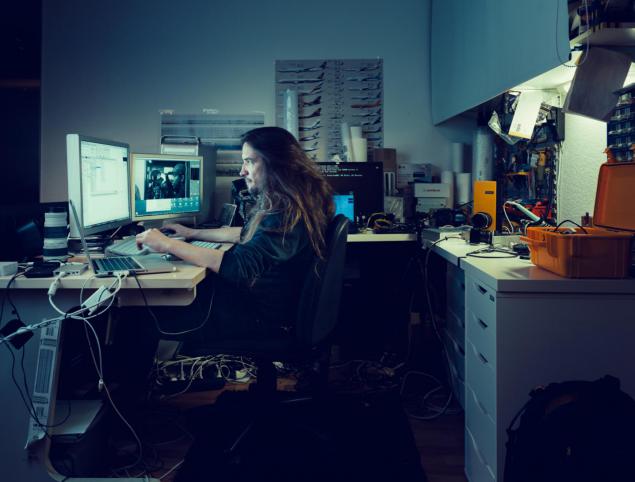
Magyar living in Berlin in January 2008, but spent only a few shows, and does not communicate with local artists. "Galleries are a little punk, and my work - the fruit of engineering work", - he said to me, brewing espresso in the kitchen while his girlfriend Porcsalma Zazi, a Hungarian translator, he knows the high school, he served in the living room Christmas cookies. Having lived in Berlin for six years, Magyar barely speaks German, which reflects his immersion in other disciplines - "I spent time here, learn two of the programming language, I no matter what do not have time," he explains - and attitude uninvolved observer, that pervades his work. As he grabs moments in the life of commuters in their series Stainless i>, and I was able to catch Magyar during a brief pause in his life, full of movement: he is always moving forward.
Magyar was born and raised in the Hungarian city of Debrecen, a regional center with 200 thousand. Residents, immediately to the west of the border with Romania. His mother was a dentist, his father - an architect and interior designer, who created the bars and restaurants for a state company during the Communist era. Senior Magyar earned the artist making workshop near his home quaint lamps and other household items made of copper. "I grew up in the workshop of his father - says Magyar. - I've learned to work with tools, I acquired a general understanding of materials. And I learned how to combine different things. " Magyar parents sent him to a primary school with intensive study of music, and he sang in the most prestigious children's choir of Hungary, speaking in Finland and Greece, where the majority of trips to the West were banned. He enrolled in the technological high school, but found that the program was too much theory, and rebelled against the discipline. "I was the only one in the class who did not have to wear uniforms. I've never been able to easily control, "- he says. Magyar abandoned his studies at the university, learned to program computers and just going to live on the money he received for his work as a graphic designer freelance, but other than that, two years led his own business, printing corporate logos on pencils and lighters. He told me: "It was terrible, but it was money».
By the time the Berlin Wall fell, the Eastern bloc collapsed, and Magyar could quench the growing thirst of wandering. "I always wanted to travel, as I can remember. I was about four when I wanted to run away and wander through the world, "he recalls. "My father once told me that before there were people whose profession was to travel, and I took his word for it. I liked the idea of living with one suitcase of things, moving from place to place. She seems to be firmly stuck in my head. When I got my first paycheck, I just left. I think I'm something like a constant traveler. " Passing with a backpack of Morocco, in 27 he first came to India. "It was the most difficult place of all, where I was - he says. - The colors, the smells - all this is difficult to digest. It became for me a kind of Mecca, and I began to go back there every year ».
Life is a constant traveler hone the skills of Magyar as the observer and strengthened the feeling that he is an outsider. On the one hand it was in constant motion. On the other, he was able to remain stationary for a long time, just watching for life. Once, he spent six months studying the movement of the river in Varanasi, India's ancient religious capital on the banks of the Ganges. During that trip, he asked Zazi to bring him a book for novice photographers, which he won as a prize in elementary school. "I was almost thirty, - he said. - And I began to study the aperture, light, and began to publish in a dark room. I loved it. " A year later, he has documented daily life at a private school in Darjeeling, a hill station in the Himalayas in northeast India, and a series of black-and-white photos won first place at the annual competition of the Hungarian photography. "He has never worked too fast - says Zazi. - If it is a person or a place exciting, then spent with him for hours ».
But Magyar quickly realized that doing a simple documentary photography he was bored. He set the camera inside the cinema in Varanasi, and took photographs of spectators in near darkness with an exposure of one minute. He made frames passengers sitting in the backseat of a taxi in Calcutta, and people concluded within the doors of medical admissions and elevator in Shanghai. Hannah freezer, the former head of Light Work, based artists cooperative, which has organized an ambitious exhibition of works Magyar Kontinuum i> in three museums in the US in 2013 - Light Work in Syracuse, Houston Center for Photography and Griffinovskom Museum of Photography in Boston - says that "a series of elevators with central in understanding his work. It reflects the idea to take a camera and make it fixed, and again and again to take pictures of people. He does not look at the people appraising look. It avoids a lot of questions. Instead - just the experience of observation and presence, and the definition of life flow through this. " This work also reflected the growing interest of Magyar to the limitations of the human sensory perception when compared with what was possible with the use of new and old technologies, and became the prototype of its efforts to move the boundaries of what we can see and experience. "I wanted to make people in the cell, in a sense. I thought about how little choice we have when we choose our own way - he told me. - We can see only a narrow angle of view, no matter what we were doing. Our knowledge is really limited and very few of them ».
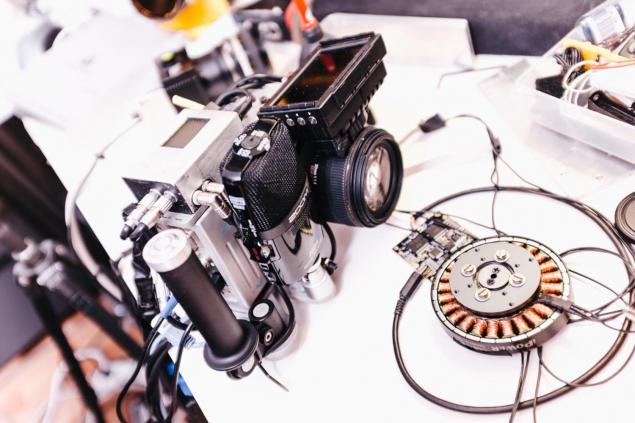
High-speed Camera Optronis, equipped with special details for video shooting Stainless i> and the modified battery. h6>
Magyar began experimenting with scanning in 2003. "I wanted to go beyond the limits of conventional photography, - he said. - I remember that little sleep. I sat all night, thinking about how to do this. " In his early experiments Magyar assembled his own primitive scanner, using East German slide projector that cast a narrow beam of light. Then he built a platform of Lego blocks, which allows it to beam "scan" the object, slowly sliding downward. Ordinary SLR camera kept all the scanned line at a time, picking them from a single image during the exposure time of one minute. Thus, the scanner minute time sliced into thin sections, and the collecting section back chamber, creating one image from all those moments. Magyar scanned himself, experimenting with different movements, which created a distorted final image. "When I turned, the resulting image shows my body is wrapped in a tailspin, - he says. - It was an interesting technological experiment, but only just. I threw it a few years ».
Nevertheless, it still resulted in the admiration of the idea of shooting the different parts of a single person or several people at different times, creating a still image from the "small pieces", as he says, Magyar. This coincided with his growing interest in what he calls "the ever-changing nature of the" constant flow of life, which did not yield to attempts simple visual display.
In 2006, when he spent several months in Shanghai, he happened to enlightenment. "I had a feeling that I will be, so to speak, to scan the flow of people. I began to look for the desired type of place where people would go at the same speed. " Magyar studied first escalators in shopping malls in Shanghai. Then his eyes fell on the city streets, especially large intersections or bus stops with a constant flow of people. As soon as his head appeared the concept, he began to develop the technology to implement it. "It was a continuous study, - he says. - I spent a few weeks before you found out all the details ».
The answer, as I understand Magyar, lying in a modified version of a slit camera, which is used to shoot a photo-finish at the race tracks and at the Olympic competitions, recording the time sequence into a single image. These cameras were rare, and worth many thousands of dollars, so the Magyar decided to make it myself. He added the objective of medium-format cameras and other sensors to write software for the new device. Total cost: $ 50. He turned inside out the traditional way of scanning when the sensor moves along a stationary object.



